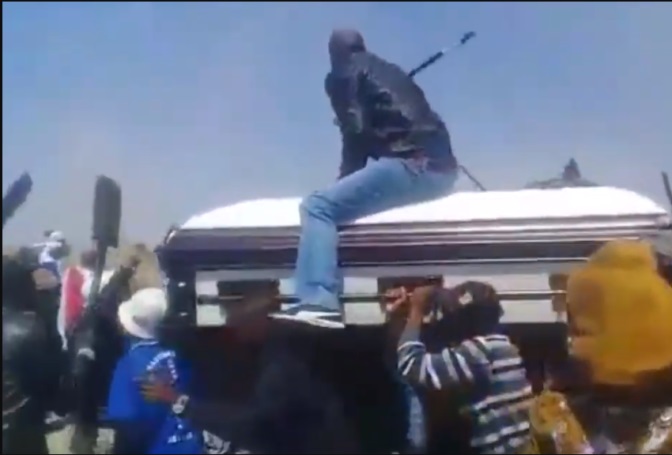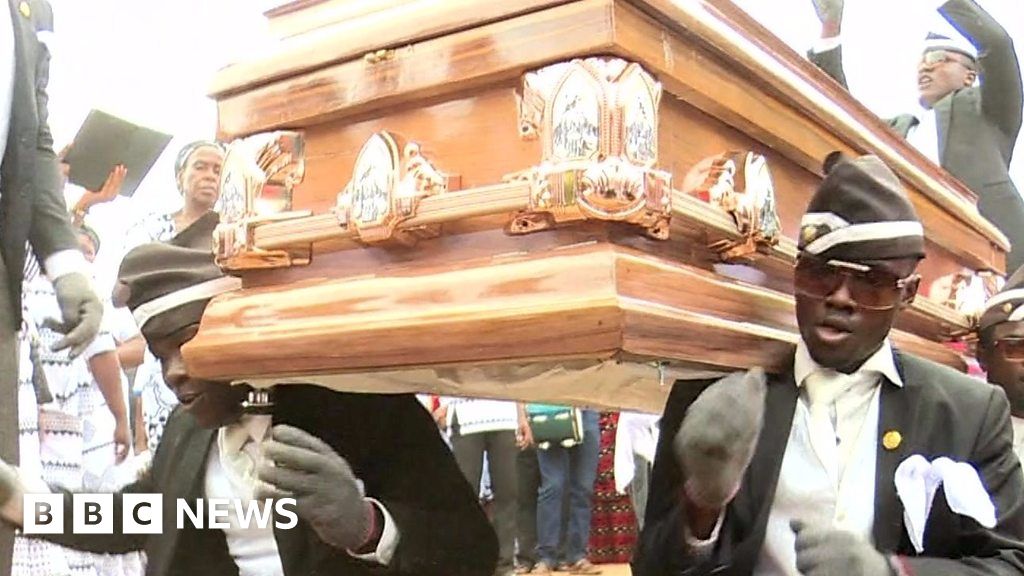African Death Rites | TraditionsCustoms.com Coffin Dance Africa

Africa, from its north to south, from east to west, has huge number of different traditions associated with death.
The Ga or Ga-Adangbe people live in Ghana. Most of them are in great Accra plains. They founded Accra, the capital city of Ghana, in the 1500s as a trading port. They believe that when a person dies, he/she moves to another life.
The Ga carpenters became world famous for the coffins they make. Some even call them “fantasy coffins”. These coffins have shapes which symbolically represent interests, activities of the deceased when he/she was alive. Coffins in the shape of plane, shoe, beer bottle, car, animal etc. are made.
Fantasy coffin by the Ga people

The best place where you can see such coffins is the High street in Teshi, Eastern Accra where there are many carpenters in this line of business. Such coffins are very expensive and their price can be equal to what average family earns in a year.
In Uganda the Baganda people prepare a grave for each individual when they are still children.
Mourning dances are often preformed. The Kenga people of central Sudan perform mourning dances called “Dodi” or “Mutu” on a burial day. The Yoruba of Nigeria have a dance wearing a likeness of the deceased. The Dogon of Mali perform masked dances ask kind of confrontation with death. For the Lugbara people of Uganda and the Angas of northern Nigeria dance is an important part of death rites too.
Majority of people in Gabon are Christians. But, different animist (spirit) beliefs are still being practiced by many. People believe in evil spirits and sorcerers who can call and use them. Death is often explained as act of an evil spirit or some bad neighbour who can cast a spell.
For the Urhobo of Nigeria death is not the end for the person and his relationship with family. The ceremonies performed are organized to show the everlasting relationship between the living and dead.
Before the burial the Urhobo communicate with the spirit of the dead and the gods. They want to know the causes of death and according to them organize appropriate burial. This tradition still exist despite the fact that most Urhobo people are Christians.

For the Urhobo death can happen because of old age, witchcraft, accident or illness and abomination. But, generally speaking the Urhobo think that there are only two kind of deaths – good death and bad death. Good death is associated with people who are 70 or more years old, had a moral life and are not members of some secret cult.
Urhobo mask
People died in a bad death, are those which died prematurely, members of witchcraft, evil people, those that died in an abominable death. Such people are not given what is called good burial. They are thrown into the evil forest to be eaten by wild animals. This is done to prevent the reincarnation of their spirit. Some criteria that differs good and bad death can be changed, like for example that good death means among other having children.
The Urhobo people believe that burial rites and ceremonies are needed because without them the spirit of the deceased will not be able to join the ancestral spirit. Good people are buried in a traditional ritual to the ancestors and gods of the land. There are prayers for the dead to protect and bless the living.
A young person who died prematurely, but lived a morally right life is buried, but without death festivities and rituals. In the coffin of the deceased people put some “weapons”, such as for example cutlass, knife, broken bottle etc. These objects should help him/her to fight and avenge his/her death.
The Urhobo believe that young people can not die. For them these deaths are caused by someone who killed them. People who died without children are buried, but with no festivities and other rituals. The reason for this is that they do not have children who will continue to have their name and perform the ancestral worship.

The Urhobo have some differences in burial of women and men. The women are buried according to reasons which caused their death. The man on the side have an ancestral burial. The reason for this fact is a belief that women do not go to the ancestral world.
The Zulu people live in the KwaZulu-Natal Province of South Africa. They believe that the death is not the end. Becoming old is seen as very positive thing. Old people are treated as sacred, kind of blessing for the community.
The Zulu have rather interesting story about death. Here it goes. Long, long time ago people did not die. But they did not know it. So, the Creator decided to send a messenger and inform people. The messenger was a chameleon. The chameleon was rather slow but the Creator think that it is not that important.
While travelling the chameleon got hungry and stopped to eat some berries. He thought that the Creator would not notice it. But the Creator found out. He was very angry. He sent the second messenger. It was a lizard. He was very fast and delivered the message. After some time the chameleon finally arrived in the village. He tried to say what was in the message but the people stopped him. They said that his journey was just a waste of time and that they already got the message.
The Zulu burn all the objects that used to belong to the deceased. They believe that by doing so evil spirits will not stay in the building where the deceased used to live.
The Maasai people of Kenya believe in one god called Enkai (Engai, Ngai). Enkai can appear as good Enkai Narok (Black God) and bad Enkai Nanyokie (Red God). Enkai is married to Olapa who is the goddess of the Moon.
Enkai created the first warrior. His name was Le-eyo (Leeyio). Enkai gave him a special chant. With reciting of this chant over dead children Le-eyo could make them alive and also immortal.
But Le-eyo was to selfish. He did not care about performing this chant for other people. One day Le-eyo's son died. He tried to recite the chant but it was to late. From this day the Maasai believe death has power over people.
The Bara people live in the south of Madagascar. They believe that their ancestors play key role in their everyday life. The body of deceased is brought in a “house of many tears”. Women arrive and weep there three times a day. During period of mourning men and women are separated. The exception is the evening feast. On the third day body is put in the family burial house. The deceased becomes a new ancestor. This fact is announced by pouring some rum on the doorway.


0 Comments
Post a Comment